关于伊格纳斯•阿巴黎创作的文字摘要
关于伊格纳斯•阿巴黎(Ignasi Aballí)创作的文字摘要1
Excerpts of texts on Ignasi Aballí's work 1
“以缺席描述真实”
作者:巴特缪•马力(Bartomeu Mari)
自二十世纪八十年代后期以来,伊格纳斯•阿巴黎(Ign
asi Aballí)的作品遵循着两种截然相悖或者至少相当迥异的实践风格。前一种是阿巴黎在其艺术事业伊始对最小化行为、细腻表达和最不易觉察之变化的探索,这种兴趣反映了阿巴黎及其同一代人所共有的反形式主义。…阿巴黎追求的第二种风格是以虚作实,并借此对其作品加以定位。从绘画到客体,从客体到再现客体;从成品到摄影,从摄影到虚构。
阿巴黎的作品同样汲取了当时过剩的图像和话语,似乎在寻求一个对立点,反作用于这种数量激增,从而寻求内容的强度。阿巴黎把现代主义座右铭“以少胜多”作为他自己的准则。他反对视觉冲击或震撼,而提倡能够在记忆中延伸的持续感受;反对速度,而引领我们走进舒缓而具有思想性的阅读。
尽管表面上保持中立,但阿巴黎的作品实际上充满了对周遭世界尖锐逆耳,有时甚为刻薄的批判。一方面,我们在一些作品中发现作为主体的艺术家消失了,而任凭灰尘累积[“灰尘(十年在工作室)"1995–2005]或阳光侵蚀[“光”(六个窗户),1993]来锻造素材。另一方面,我们面前的艺术家不遗余力地搜集、积累和编排报纸上得来的信息,收集被无数次重复的影象,或向其他无名之辈致敬,让他们成为不可解读之图像的缔造者。
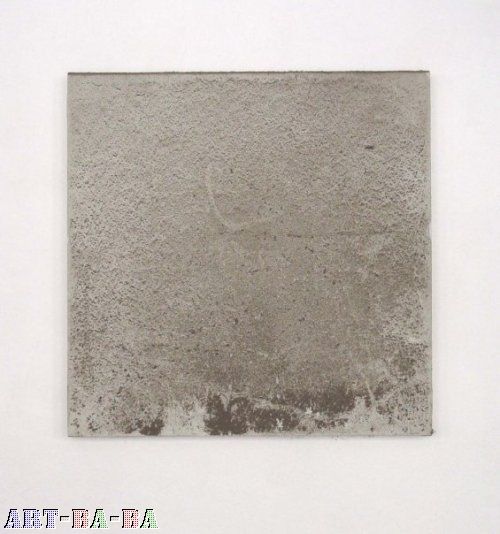
'Dust (Ten years in the studio)'
“灰尘(十年在工作室)"
1995–2005
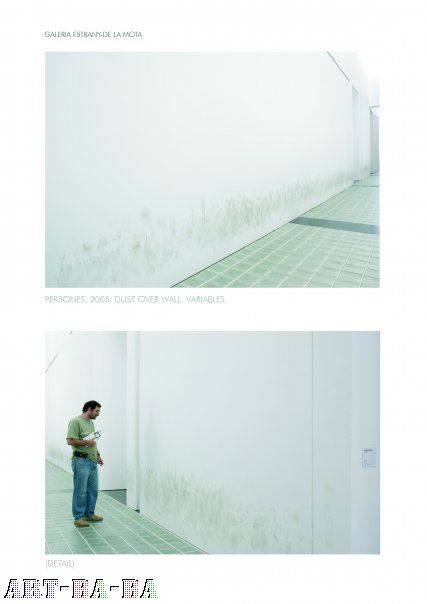
'Dust (Ten years in the studio)'
“灰尘(十年在工作室)"
1995–2005
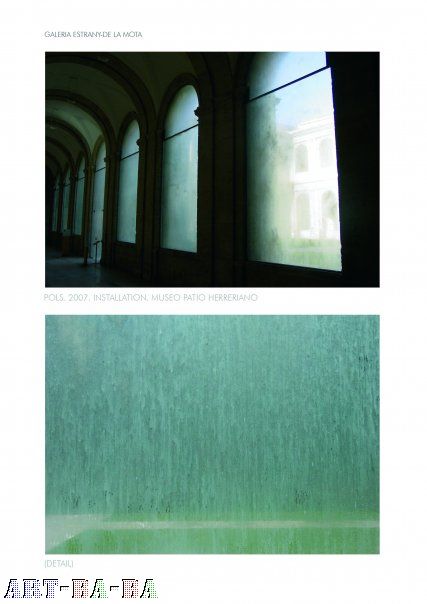
'Dust (Ten years in the studio)'
“灰尘(十年在工作室)"
1995–2005
报纸是光阴飞逝的明证。手握日报一份,便多抓住了些现实的痕迹。当下不过是一瞥的瞬间,明日复有明日的新刊。“日历”(2005)通过一家报纸每日头版刊印的照片,讲述了一年时间的流逝。仿佛12个月的日历牌上的天数,展示的这些照片既无标题亦无标识,却如同X射线一般,述说了一月内每一天中显著的个性和事件。
Portrait of the Real through Absence
In 'Ignasi Aballi. 0-24 h', Museu d'Art Contemporani Barcelona, Barcelona, in collaboration with Museu de Arte Contemporânea de Serralves, Oporto and Ikon Gallery, Birmingham, 2005–6.
By Bartomeu Marí
Since the late-1980s, the work of Ignasi Aballí has developed around two apparently contradictory or at least very different lines of practice. The first of these is the exploration he began at the beginning of his artistic career into minimal activity, miniscule gesture and the most imperceptible modification, a concern that reveals an anti-formalism he shares with other members of his generation. [...] The second line Aballí has followed is a cultivation of fiction as material and as a means of locating his work. [...] From painting to the object, from the object to its representation, from ready made to photography and from photography to fiction. [...] Aballí’s work from this time also drinks of the excess of images and discourses of the moment, seeming to seek a counterpoint, the negative of this quantitative increase, to find intensity of content. Aballí takes as his own the modernist maxim of “doing more with less”. Against the shock or surprise of vision, the artist proposes the continuing perception that should be prolonged in memory. Against speed, he invites us to slow, thoughtful reading.
[...] Though apparently neutral, Aballí’s works are in fact infused with sharp, uncomfortable and sometimes bitterly critical content about the world around us. On the one hand, we find works in which the artist disappears as a subject and allows the accumulation of dust ['Dust (Ten years in the studio)', 1995–2005] or the sun’s corrosive action on the materials to form them ['Light' (six windows), 1993]. On the other, we are confronted by an artist who meticulously collects, inventories and arranges information from the newspapers, gathers images reproduced to infinity or pays homage to the anonymity of others, turning them into the creators of illegible images.
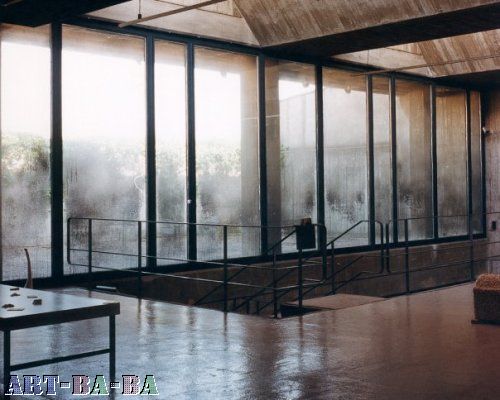
'Dust (Ten years in the studio)'
“灰尘(十年在工作室)"
1995–2005
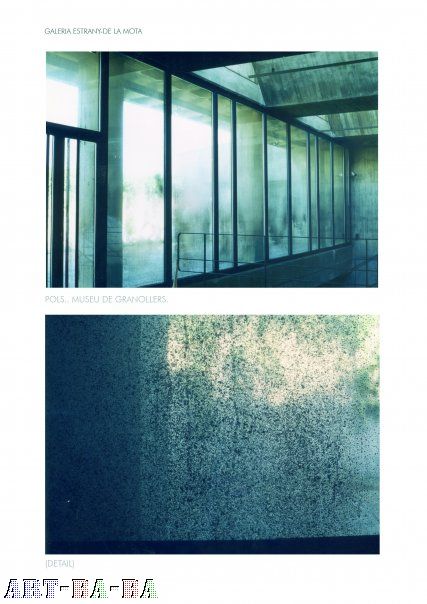
[...] Newspapers provide ineluctable proof of the fleeting nature of time. To hold a daily newspaper in our hands is to accumulate traces of reality. The present lasts the distance of a glimpse, returning the next day with a new edition. 'Calendari' [Calendar] (2005) narrates the elapsing of a whole year through the photographs published every day on the front page of a particular newspaper [El País]. Displayed with neither captions nor identification, as if they were the numbers of days on a 12-month calendar, these images provide an X-ray of the whole month, a narrative on the outstanding personalities and events of each day.
Excerpts of texts on Ignasi Aballí's work 1
“以缺席描述真实”
作者:巴特缪•马力(Bartomeu Mari)
自二十世纪八十年代后期以来,伊格纳斯•阿巴黎(Ign
asi Aballí)的作品遵循着两种截然相悖或者至少相当迥异的实践风格。前一种是阿巴黎在其艺术事业伊始对最小化行为、细腻表达和最不易觉察之变化的探索,这种兴趣反映了阿巴黎及其同一代人所共有的反形式主义。…阿巴黎追求的第二种风格是以虚作实,并借此对其作品加以定位。从绘画到客体,从客体到再现客体;从成品到摄影,从摄影到虚构。
阿巴黎的作品同样汲取了当时过剩的图像和话语,似乎在寻求一个对立点,反作用于这种数量激增,从而寻求内容的强度。阿巴黎把现代主义座右铭“以少胜多”作为他自己的准则。他反对视觉冲击或震撼,而提倡能够在记忆中延伸的持续感受;反对速度,而引领我们走进舒缓而具有思想性的阅读。
尽管表面上保持中立,但阿巴黎的作品实际上充满了对周遭世界尖锐逆耳,有时甚为刻薄的批判。一方面,我们在一些作品中发现作为主体的艺术家消失了,而任凭灰尘累积[“灰尘(十年在工作室)"1995–2005]或阳光侵蚀[“光”(六个窗户),1993]来锻造素材。另一方面,我们面前的艺术家不遗余力地搜集、积累和编排报纸上得来的信息,收集被无数次重复的影象,或向其他无名之辈致敬,让他们成为不可解读之图像的缔造者。

'Dust (Ten years in the studio)'
“灰尘(十年在工作室)"
1995–2005

'Dust (Ten years in the studio)'
“灰尘(十年在工作室)"
1995–2005

'Dust (Ten years in the studio)'
“灰尘(十年在工作室)"
1995–2005
报纸是光阴飞逝的明证。手握日报一份,便多抓住了些现实的痕迹。当下不过是一瞥的瞬间,明日复有明日的新刊。“日历”(2005)通过一家报纸每日头版刊印的照片,讲述了一年时间的流逝。仿佛12个月的日历牌上的天数,展示的这些照片既无标题亦无标识,却如同X射线一般,述说了一月内每一天中显著的个性和事件。
Portrait of the Real through Absence
In 'Ignasi Aballi. 0-24 h', Museu d'Art Contemporani Barcelona, Barcelona, in collaboration with Museu de Arte Contemporânea de Serralves, Oporto and Ikon Gallery, Birmingham, 2005–6.
By Bartomeu Marí
Since the late-1980s, the work of Ignasi Aballí has developed around two apparently contradictory or at least very different lines of practice. The first of these is the exploration he began at the beginning of his artistic career into minimal activity, miniscule gesture and the most imperceptible modification, a concern that reveals an anti-formalism he shares with other members of his generation. [...] The second line Aballí has followed is a cultivation of fiction as material and as a means of locating his work. [...] From painting to the object, from the object to its representation, from ready made to photography and from photography to fiction. [...] Aballí’s work from this time also drinks of the excess of images and discourses of the moment, seeming to seek a counterpoint, the negative of this quantitative increase, to find intensity of content. Aballí takes as his own the modernist maxim of “doing more with less”. Against the shock or surprise of vision, the artist proposes the continuing perception that should be prolonged in memory. Against speed, he invites us to slow, thoughtful reading.
[...] Though apparently neutral, Aballí’s works are in fact infused with sharp, uncomfortable and sometimes bitterly critical content about the world around us. On the one hand, we find works in which the artist disappears as a subject and allows the accumulation of dust ['Dust (Ten years in the studio)', 1995–2005] or the sun’s corrosive action on the materials to form them ['Light' (six windows), 1993]. On the other, we are confronted by an artist who meticulously collects, inventories and arranges information from the newspapers, gathers images reproduced to infinity or pays homage to the anonymity of others, turning them into the creators of illegible images.

'Dust (Ten years in the studio)'
“灰尘(十年在工作室)"
1995–2005

[...] Newspapers provide ineluctable proof of the fleeting nature of time. To hold a daily newspaper in our hands is to accumulate traces of reality. The present lasts the distance of a glimpse, returning the next day with a new edition. 'Calendari' [Calendar] (2005) narrates the elapsing of a whole year through the photographs published every day on the front page of a particular newspaper [El País]. Displayed with neither captions nor identification, as if they were the numbers of days on a 12-month calendar, these images provide an X-ray of the whole month, a narrative on the outstanding personalities and events of each day.
关于伊格纳斯•阿巴黎(Ignasi Aballí)创作的文字摘要 2
Excerpts of texts on Ignasi Aballí's work 2
伊格纳斯•阿巴黎接受丹·卡梅伦的采访
起初,我的工作是与传统绘画紧密联系在一起的,但在这个
过程中传统绘画带着走到了我不再知道如何继续使用这些传统媒介的地步。所以我就开始寻找与绘画相关但又不同的表达方式,因此,我不再表现现实,而是开始使用更多的观念元素,在其中,概念是越来越重要而绘画元素则越来越少。[在]20世纪90年代初,我用阳光来创作作品。光在支撑物上进行绘画。我先是用这种技术来呈现我的工作室和我的房子,因为光线通过这些空间进入了我工作和生活的地方。后来,我通过图片的缺席来呈现他们的存在:当人们从墙上把图片摘走后,图片在墙上留下了痕迹。因为光线的效果,你可以看到图片在墙上留下的印迹。
在“浪费”[“Malgastar”(Waste),2001中],我从工厂和艺术品商店买了很多的涂料,然后在不做任何处理的情况下让涂料在罐子里慢慢变干。一方面,我想阐释对于材料消极的或者不正确的应用,正像乔治·巴塔耶用他自己的专用名词dépense (“malgasto”, waste)对此作出的解释。另一方面,作品也指出当我正在思考怎样处理涂料的时候,它已经慢慢变干了。我非常缓慢地工作着,进行一项新的创作对我来说相当困难,因为在我判断事物是否可行之前,我要花很多时间和精力来思考。
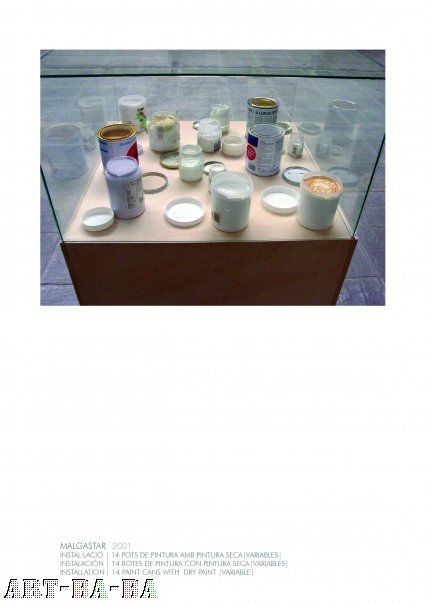
'Malgastar' (Waste, 2001)
“浪费”
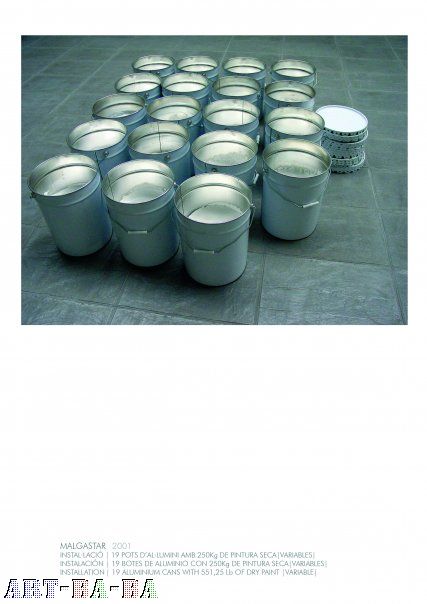
'Malgastar' (Waste, 2001)
“浪费”
乔治佩雷克, 一个我非常愿意与之亲近的作家,他的作品为我的许多项目做了铺垫。他说让他着迷的是喧闹的背景音,每天的喃喃低语,我们从来没有留意过这些声音,但是当我们真正注意它们的时候,它们就会变得复杂而有趣。我完全赞同这一理论,这也与是杜尚的“次薄”理论非常接近(“infrathin”)。
我的工作室在一个19世纪的工业大楼里,里面经常有很多灰尘。如果你把一页纸放到桌上,不出三四天,它上面就会铺满一层薄薄的灰尘。当我意识到自己必须在搬到一个更干净整洁的工作室或者将灰尘作为作品的一部分这二者之间做出决择时,我决定选择后者。[…] 我看到这是一个有很多可能性的材料。尘埃是一种合成材料,世界上的所有东西在被侵蚀后混合成了尘埃。尘埃也是一种大家都不想要的终极的、烦人的、剩余的材料。我必须非常巧妙地运用它,将它的特点,尤其是它的脆弱性考虑进去。
我开始收集报纸上出现的各种统计数据并把它们分组排列:比如,死亡人数、受伤或失踪人数,按照时间顺序或按照金钱的总数等。当我针对一个单词或者一组数据收集到足够的样本时,我就开始进行剪报拼贴。[这些]不是捏造的数字,它们反应的是真实的情况。我们可以把它们与所有的不管出于什么原因在报纸上出现过的消息联系到一起。如果我能想象出这些剪报所代表的景象,如果我把这些数字的总和变为视觉上的图像,这将是一个让我震惊的、巨大的、可怕的死亡形象。这也表现了当文字转换成图像时,文字所暗含的容量,反之亦然。在报纸上,图像和文字之间的关系是非常重要。
'Ignasi Aballí interviewed by Dan Cameron' in 'Ignasi Aballi. 0-24 h', Museu d'Art Contemporani Barcelona, Barcelona, in collaboration with Museu de Arte Contemporânea de Serralves, Oporto and Ikon Gallery, Birmingham, 2005–6.
At first my work was closely associated with traditional painting, but the processes I followed in it led me to a point where I no longer knew how to carry on using these traditional media. So I started to look for different ways of relating to painting and as a result, I stopped trying to represent reality and started to use more conceptual elements in which the idea was more and more important and the fact of painting was less and less. [In] the early 1990s, I was producing works made with sunlight. Light did the drawing, painted on the support. I used this technique firstly to represent the windows of my studio and my house, as those are the spaces through which the light enters my places of working and living. Later, what I did was to suggest the presence of pictures through their absence, through the trace they leave when you take them off a wall. What you could see was the mark they left on the wall due to the effect of the light.
[...] In 'Malgastar' (Waste, 2001) I bought a lot of paint from the industry and from artists’ paint shops, then let it go dry in the tin without doing anything with it. On the one hand I wanted to explain the negative or incorrect use of material, in the same way that Georges Bataille explains it with his term dépense (“malgasto”, waste). On the other, though, this work also indicates that the paint has dried whilst I am thinking about what to do with it. I work very slowly, it is hard for me to produce new works because I think so much about things before I decide they are valid.
[...] Georges Perec, a writer I feel very close to and whose writing has served as the basis for some of my projects, said that what fascinated him was the background noise, the murmur of the everyday, that which we never perceive but which, when we do pay attention to it, turns out to be very interesting and complex. I fully subscribe to this theory, which is also close to Duchamp’s idea of inframince (“infrathin”).
[...] In my studio, a 19th-century industrial building, dust is a constant presence. If you leave a piece of paper on the desk, in three or four days it is covered with a thin layer of dust. When I realised this I had to face the dilemma of either moving, going to a cleaner studio, or using dust as a material in my work. And I chose the second option. [...] I saw that it was a material with lots of possibilities. Dust is a material of synthesis, a mixture of everything that becomes eroded in the world. It is also a terminal, annoying, residual material that we don’t want. I needed to use it in a subtle way, taking its characteristics, particularly its fragility, into account.
[...] I began to cut out the statistical quantities of all kinds that appeared in the news and then arranged them in groups: for instance, numbers of people, of dead, wounded or lost, by period of time, according to sums of money, etc. When I had enough examples of a word or a group, I made collages from the cuttings [‘Lists’ (1997–2005)] . [...] [These] are not made-up figures, they correspond to real situations, and we can link them all to events that have, for whatever reason, been in the news. [...] If I ever imagined the images the cuttings represent, if I turned the sum total of the figures into a visual image, it would be a huge, monstrous image of death, devastating me. This also shows the suggestive capacity of the textual, when text becomes image and vice versa. The relation between image and text is very important in newspapers.
挺象楚云的作品的
这是储运的主爷爷啊
不错的艺术家!


SUITCASE艺术项目Ⅱ
SUITCASE ART PROJECTS 2
没有,有
Nothing, or Something
伊格纳斯·阿巴黎
Ignasi Aballí
策展人:纬度策展办公室(马可思·安得鲁斯和玛丽安娜·卡尼帕露娜)
Curators: Latitudes (Max Andrews and Mariana Cánepa Luna)
SUITCASE艺术项目由今日美术馆主办,策展人、批评家卢迎华担任艺术总监。
Suitcase Art Projects is organised by the Today Art Museum under the artistic direction of curator and critic Carol Yinghua Lu.
开幕时间:5月22日星期五6.30pm
Opening: 6.30pm, Friday, May 22
展览时间:2009年5月22日至7月22日
Exhibition Dates: 22 May – 22 July 2009
地点:北京银泰中心 悦·生活
Venue: Park Life, Beijing Yintai Centre
地址:北京朝阳区建外大街2号
Address: No. 2 Jianwai Street, Chaoyang District, Beijing
时间:周一至周日早上10点至下午10点
Opening Hours: 10am – 10pm, Monday – Sunday
该项目得到了Institut Ramon Llull、今日美术馆、银泰中心和上海滩等的支持。
This project is supported by Institut Ramon Llull, Today Art Museum, Yintai Center and Shanghai Tang.
www.suitcaseartprojects.com
www.todayartmuseum.com
www.llull.cat
www.LTTDS.org
伊 格纳斯•阿巴黎的新作是为SUITCASE艺 术项目创作的,包含了八个橱窗的作品,它呼应了银泰中心的商业语境,以及关于缺席、虚无和隐形的艺术史。阿巴黎的现场装置中有的沿用了典型的商业展示所使 用的手法,有的则改编或者强调了虚无的物理成分,比如光和空气。根据沃尔特•本雅明在《拱廊街计划》中对于消费主义中心的讨论,“没有,有”这个展览计划 所思考的是展示的条件和对展示的期望。通过对日常材料的使用,包括灰尘、图像和简单的文字——这些是他在创作中最喜欢使用的材料——阿巴黎在运用观念的魅 力和分析性的严谨“揭示虚无”的同时,探讨了哲学中最核心和最复杂的问题:为什么是有而不是无?
该项目的出版物将于2009年6月出版发行,其中将包含现场装置的图片和由纬度策展工作室撰写的文章。
Ignasi Aballí’s new project for the eight windows of SUITCASE Art Projects responds to the retail context of the Yintai Centre as well as an artistic history of absence, nothingness and invisibility. While some of his installations adopt the characteristics of commercial presentations, others adapt and enhance the physical components of apparent emptiness, such as light and air. Following Walter Benjamin’s concern with centres of consumerism in The Arcades Project, Nothing, or Something is preoccupied with the conditions and expectations of display. Using the everyday materials which he favours in his practice, including dust, found imagery and simple lettering, Aballí ‘reveals nothing’ with a conceptual charm and analytical rigour while addressing philosophy's central and most perplexing question: Why is there something rather than nothing?
A publication with installation images and an essay by Latitudes will be published in June 2009.
伊格纳斯·阿巴黎(Ignasi Aballí,巴塞罗那,1958年)
伊 格纳斯•阿巴黎的创作从1980年代末开始被展出和介绍,他和其他同时期一起涌现出的艺术家被称为“加泰罗尼亚艺术家”,他们通过对影像、绘画、摄影和雕 塑的深刻反思,复原观念的实践。他的作品特点鲜明,常常使用日常生活中不起眼的元素——如报纸、灰尘、日历,或者分类系统,如色码表、列表、目录和档案。 他为SUITCASE艺术项目创作的作品,与一个他在艺术实践中的永恒主题有关,即虚无、透明和细微。
他 近期的个展有:“可能/很可能”西班牙马德里 Galería Elba Benítez(2009);“展示”比利时布鲁塞尔Meessen De Clercq(2008);“没有活动”,葡萄牙波尔蒂芒Museo Municipal de Portimão(2008);“杂草”,西班牙马德里Real Jardín Botánico (2008);“分类”西班牙巴塞罗那Galería Estrany-De la Mota (2008);“0-24h”西班牙巴塞罗那 (巡展) (2005–6)。他参加过的部分群展有:“抽空”('Tiempo al Tiempo/Taking Time')西班牙比戈当代艺术馆(2007);“静止的生活:艺术、生态和政治变化”,阿拉伯联合酋长国第八届沙加双年展(2007);“感官思索,意 识触摸”意大利威尼斯第52届威尼斯双年展(2007);“不可触摸”尼斯维拉阿尔松国家当代艺术中心(2006); “开始是旅行”('En el principio era el viaje'), 西班牙庞特维德拉双年展(2004).
Ignasi Aballí (Barcelona, Spain, 1958) began exhibiting in the late-1980s, emerging alongside a generation of Catalan artists that recuperated conceptual practices through an intense reflection on the status of the image, painting, photography and representation. His work is often characterised by the use of unremarkable elements of daily life – newspapers, dust, calendars – as well as systems of classification such as colour charts, lists, inventories and archives. His project for SUITCASE Art Projects connects with an ever present theme in his practice, that of absence, transparency and imperceptibility.
His recent solo shows include: 'Possible/Probable', Galería Elba Benítez, Madrid, Spain (2009); 'To Show', Meessen De Clercq, Brussels, Belgium (2008); 'Sem Actividade', Museo Municipal de Portimão, Portimão, Portugal (2008); 'Malas Hierbas', Real Jardín Botánico, Madrid, Spain (2008); 'Classificar', Galería Estrany-De la Mota, Barcelona, Spain (2008); '0–24h', Museu d'Art Contemporani de Barcelona, Barcelona, Spain (touring show) (2005–6). Amongst his group shows are: 'Tiempo al Tiempo/Taking Time', Museo de Arte Contemporaneo Vigo, Vigo, Spain (2007); 'Still Life: Art, Ecology and the Politics of Change', Sharjah Biennial 8, United Arab Emirates (2007); 'Think with the senses, feel with the mind', 52nd Biennale di Venezia, Venice, Italy (2007); 'Intouchable', Centre National d'Art Contemporain Villa Arson. Nice (2006); 'En el principio era el viaje', Bienal de Pontevedra, Pontevedra, Spain (2004).
纬度策展工作室 (Latitudes)
“ 纬度”是位于巴塞罗那的策展工作室,2005年4月由马克斯·安德鲁斯(巴斯,英国,1975)和马里亚纳·卡尼帕·卢娜(蒙得维的亚,乌拉 圭,1977)成立。“纬度”与艺术家和机构合作,在本地、泛欧洲和国际范围内致力于展览、公共事务、会议、编撰和研究策划的构思、组织和制作。“纬度” 是Archive Books(都灵/柏林)的编委会成员,同时担任APT Intelligence机构的策展顾问。www.LTTDS.org
Latitudes is a Barcelona-based curatorial office founded in April 2005 by Max Andrews (Bath, United Kingdom, 1975) and Mariana Cánepa Luna (Montevideo, Uruguay, 1977). Latitudes collaborates with artists and institutions in the conception, organisation and production of exhibitions, public commissions, conferences, editorial and research initiatives across local, pan-European and international situations. Latitudes is on the Editorial Board of Archive Books, Turin/Berlin, and is a curatorial advisor for APT Intelligence. www.LTTDS.org
SUITCASE艺术项目
SUITCASE是一个旅行中的艺术项目。
你在哪,它就到哪。
SUITCASE艺术项目与具体的现实空间和观念语境展开
对话和互动,在任何特定的情境中自我转化并潜入/嵌入
其中。SUITCASE艺术项目强调的是相遇而不是对抗,是
潜移默化而不是针锋相对。
SUITCASE追随着情境主义的传统在日常的生活中重构
精神的空间。
SUITCASE是一个停顿。
SUITCASE是一个传言,弥漫在空气中。
SUITCASE寄生并生长着。
SUITCASE ART PROJECTS
SUITCASE is an art project that travels.
Instead of waiting for you to come close, it travels to
wherever you are.
SUITCASE Art Projects are engaged in exchanges
and interactions with specific physical and conceptual
contexts and are highly adaptable to any given
situation. SUITCASE Art Projects are about encounters
not confrontations.
SUITCASE follows the Situationist tradition to create
intellectual engagements and discussions in both the
most and least expected contexts.
SUITCASE is a pause.
SUITCASE is a hearsay, circulating in the air.
SUITCASE parasites and grows.
SUITCASE ART PROJECTS 2
没有,有
Nothing, or Something
伊格纳斯·阿巴黎
Ignasi Aballí
策展人:纬度策展办公室(马可思·安得鲁斯和玛丽安娜·卡尼帕露娜)
Curators: Latitudes (Max Andrews and Mariana Cánepa Luna)
SUITCASE艺术项目由今日美术馆主办,策展人、批评家卢迎华担任艺术总监。
Suitcase Art Projects is organised by the Today Art Museum under the artistic direction of curator and critic Carol Yinghua Lu.
开幕时间:5月22日星期五6.30pm
Opening: 6.30pm, Friday, May 22
展览时间:2009年5月22日至7月22日
Exhibition Dates: 22 May – 22 July 2009
地点:北京银泰中心 悦·生活
Venue: Park Life, Beijing Yintai Centre
地址:北京朝阳区建外大街2号
Address: No. 2 Jianwai Street, Chaoyang District, Beijing
时间:周一至周日早上10点至下午10点
Opening Hours: 10am – 10pm, Monday – Sunday
该项目得到了Institut Ramon Llull、今日美术馆、银泰中心和上海滩等的支持。
This project is supported by Institut Ramon Llull, Today Art Museum, Yintai Center and Shanghai Tang.
www.suitcaseartprojects.com
www.todayartmuseum.com
www.llull.cat
www.LTTDS.org
伊 格纳斯•阿巴黎的新作是为SUITCASE艺 术项目创作的,包含了八个橱窗的作品,它呼应了银泰中心的商业语境,以及关于缺席、虚无和隐形的艺术史。阿巴黎的现场装置中有的沿用了典型的商业展示所使 用的手法,有的则改编或者强调了虚无的物理成分,比如光和空气。根据沃尔特•本雅明在《拱廊街计划》中对于消费主义中心的讨论,“没有,有”这个展览计划 所思考的是展示的条件和对展示的期望。通过对日常材料的使用,包括灰尘、图像和简单的文字——这些是他在创作中最喜欢使用的材料——阿巴黎在运用观念的魅 力和分析性的严谨“揭示虚无”的同时,探讨了哲学中最核心和最复杂的问题:为什么是有而不是无?
该项目的出版物将于2009年6月出版发行,其中将包含现场装置的图片和由纬度策展工作室撰写的文章。
Ignasi Aballí’s new project for the eight windows of SUITCASE Art Projects responds to the retail context of the Yintai Centre as well as an artistic history of absence, nothingness and invisibility. While some of his installations adopt the characteristics of commercial presentations, others adapt and enhance the physical components of apparent emptiness, such as light and air. Following Walter Benjamin’s concern with centres of consumerism in The Arcades Project, Nothing, or Something is preoccupied with the conditions and expectations of display. Using the everyday materials which he favours in his practice, including dust, found imagery and simple lettering, Aballí ‘reveals nothing’ with a conceptual charm and analytical rigour while addressing philosophy's central and most perplexing question: Why is there something rather than nothing?
A publication with installation images and an essay by Latitudes will be published in June 2009.
伊格纳斯·阿巴黎(Ignasi Aballí,巴塞罗那,1958年)
伊 格纳斯•阿巴黎的创作从1980年代末开始被展出和介绍,他和其他同时期一起涌现出的艺术家被称为“加泰罗尼亚艺术家”,他们通过对影像、绘画、摄影和雕 塑的深刻反思,复原观念的实践。他的作品特点鲜明,常常使用日常生活中不起眼的元素——如报纸、灰尘、日历,或者分类系统,如色码表、列表、目录和档案。 他为SUITCASE艺术项目创作的作品,与一个他在艺术实践中的永恒主题有关,即虚无、透明和细微。
他 近期的个展有:“可能/很可能”西班牙马德里 Galería Elba Benítez(2009);“展示”比利时布鲁塞尔Meessen De Clercq(2008);“没有活动”,葡萄牙波尔蒂芒Museo Municipal de Portimão(2008);“杂草”,西班牙马德里Real Jardín Botánico (2008);“分类”西班牙巴塞罗那Galería Estrany-De la Mota (2008);“0-24h”西班牙巴塞罗那 (巡展) (2005–6)。他参加过的部分群展有:“抽空”('Tiempo al Tiempo/Taking Time')西班牙比戈当代艺术馆(2007);“静止的生活:艺术、生态和政治变化”,阿拉伯联合酋长国第八届沙加双年展(2007);“感官思索,意 识触摸”意大利威尼斯第52届威尼斯双年展(2007);“不可触摸”尼斯维拉阿尔松国家当代艺术中心(2006); “开始是旅行”('En el principio era el viaje'), 西班牙庞特维德拉双年展(2004).
Ignasi Aballí (Barcelona, Spain, 1958) began exhibiting in the late-1980s, emerging alongside a generation of Catalan artists that recuperated conceptual practices through an intense reflection on the status of the image, painting, photography and representation. His work is often characterised by the use of unremarkable elements of daily life – newspapers, dust, calendars – as well as systems of classification such as colour charts, lists, inventories and archives. His project for SUITCASE Art Projects connects with an ever present theme in his practice, that of absence, transparency and imperceptibility.
His recent solo shows include: 'Possible/Probable', Galería Elba Benítez, Madrid, Spain (2009); 'To Show', Meessen De Clercq, Brussels, Belgium (2008); 'Sem Actividade', Museo Municipal de Portimão, Portimão, Portugal (2008); 'Malas Hierbas', Real Jardín Botánico, Madrid, Spain (2008); 'Classificar', Galería Estrany-De la Mota, Barcelona, Spain (2008); '0–24h', Museu d'Art Contemporani de Barcelona, Barcelona, Spain (touring show) (2005–6). Amongst his group shows are: 'Tiempo al Tiempo/Taking Time', Museo de Arte Contemporaneo Vigo, Vigo, Spain (2007); 'Still Life: Art, Ecology and the Politics of Change', Sharjah Biennial 8, United Arab Emirates (2007); 'Think with the senses, feel with the mind', 52nd Biennale di Venezia, Venice, Italy (2007); 'Intouchable', Centre National d'Art Contemporain Villa Arson. Nice (2006); 'En el principio era el viaje', Bienal de Pontevedra, Pontevedra, Spain (2004).
纬度策展工作室 (Latitudes)
“ 纬度”是位于巴塞罗那的策展工作室,2005年4月由马克斯·安德鲁斯(巴斯,英国,1975)和马里亚纳·卡尼帕·卢娜(蒙得维的亚,乌拉 圭,1977)成立。“纬度”与艺术家和机构合作,在本地、泛欧洲和国际范围内致力于展览、公共事务、会议、编撰和研究策划的构思、组织和制作。“纬度” 是Archive Books(都灵/柏林)的编委会成员,同时担任APT Intelligence机构的策展顾问。www.LTTDS.org
Latitudes is a Barcelona-based curatorial office founded in April 2005 by Max Andrews (Bath, United Kingdom, 1975) and Mariana Cánepa Luna (Montevideo, Uruguay, 1977). Latitudes collaborates with artists and institutions in the conception, organisation and production of exhibitions, public commissions, conferences, editorial and research initiatives across local, pan-European and international situations. Latitudes is on the Editorial Board of Archive Books, Turin/Berlin, and is a curatorial advisor for APT Intelligence. www.LTTDS.org
SUITCASE艺术项目
SUITCASE是一个旅行中的艺术项目。
你在哪,它就到哪。
SUITCASE艺术项目与具体的现实空间和观念语境展开
对话和互动,在任何特定的情境中自我转化并潜入/嵌入
其中。SUITCASE艺术项目强调的是相遇而不是对抗,是
潜移默化而不是针锋相对。
SUITCASE追随着情境主义的传统在日常的生活中重构
精神的空间。
SUITCASE是一个停顿。
SUITCASE是一个传言,弥漫在空气中。
SUITCASE寄生并生长着。
SUITCASE ART PROJECTS
SUITCASE is an art project that travels.
Instead of waiting for you to come close, it travels to
wherever you are.
SUITCASE Art Projects are engaged in exchanges
and interactions with specific physical and conceptual
contexts and are highly adaptable to any given
situation. SUITCASE Art Projects are about encounters
not confrontations.
SUITCASE follows the Situationist tradition to create
intellectual engagements and discussions in both the
most and least expected contexts.
SUITCASE is a pause.
SUITCASE is a hearsay, circulating in the air.
SUITCASE parasites and grows.